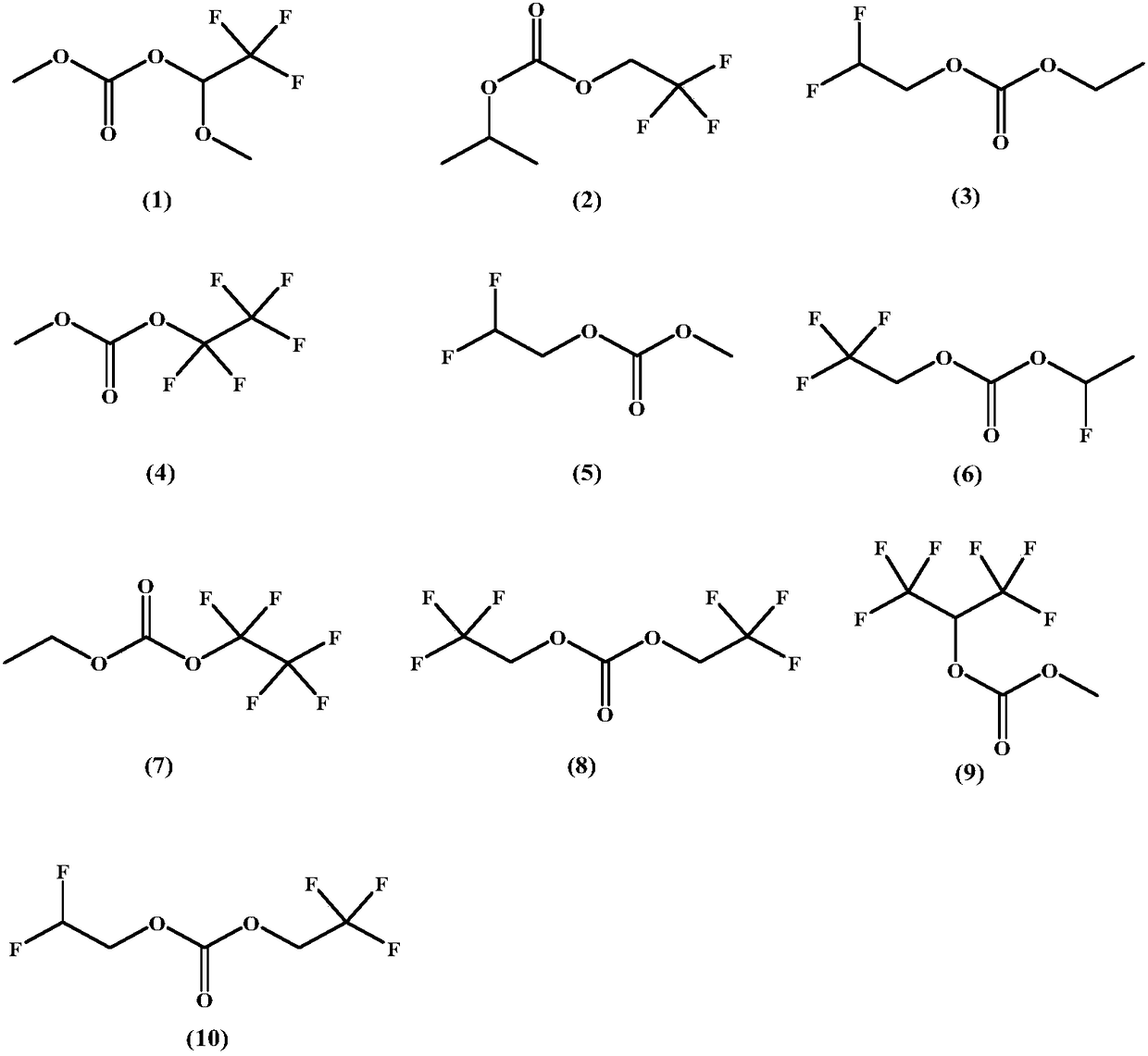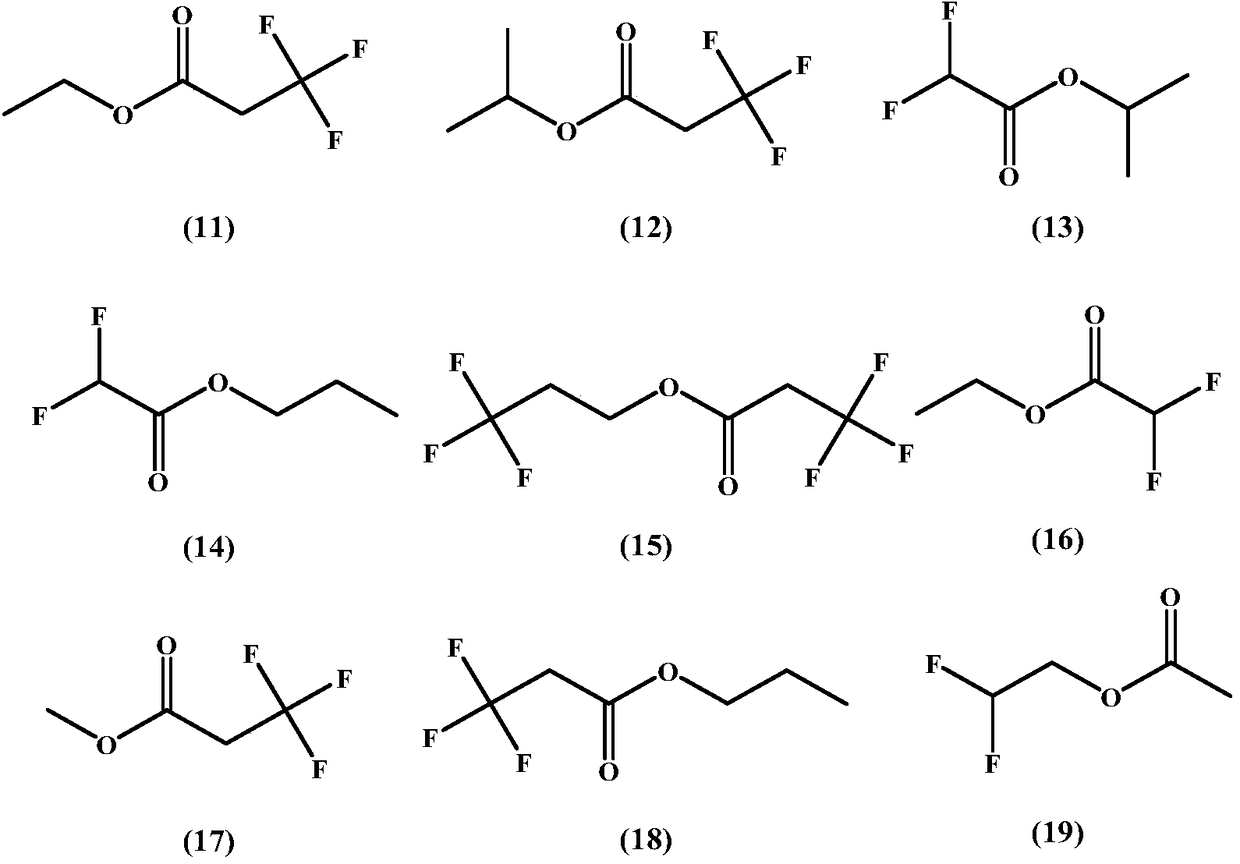A chain fluoroester compound and its use as an electrolyte solvent for lithium ion batteries
A technology of lithium ion batteries and ester compounds, which is applied in the field of lithium ion batteries, can solve the problems of volume expansion and discharge capacity reduction, material structure distortion, and cycle performance of lithium ion secondary batteries, etc., so as to reduce flammability and improve flame retardancy. Effects and safety effects
- Summary
- Abstract
- Description
- Claims
- Application Information
AI Technical Summary
Problems solved by technology
Method used
Image
Examples
Embodiment 1-1
[0028] Electrolyte preparation steps: In a glove box filled with argon, ethylene carbonate (EC), propylene carbonate (PC), ethyl methyl carbonate (EMC) and diethyl carbonate (DEC) were mixed according to the weight ratio of 25:5 : 50:20 ratio is mixed, then to the mixed solvent, add the chain fluorocarbonate solvent (specifically as shown in the list) shown in the compound (1) based on the total mass of solvent 5wt%, and slowly add 12.5 wt% lithium hexafluorophosphate, after that, add 0.5% vinylene carbonate (VC), 1.5% 1,3-propane sultone (1,3-PS), 1% difluoro Lithium phosphate (LiPO 2 f 2 ), 1% fluoroethylene carbonate (FEC), and stir to obtain the lithium-ion battery electrolyte of Example 1-1.
[0029] Inject the prepared non-aqueous electrolyte solution for lithium-ion batteries into fully dried 4.5V lithium cobalt oxide / graphite soft-pack batteries, and perform battery performance tests after shelving at 45°C, high-temperature fixture formation, and secondary sealing. ...
Embodiment 2-1
[0045] Electrolyte preparation steps: In a glove box filled with argon, ethylene carbonate (EC), propylene carbonate (PC), ethyl methyl carbonate (EMC) and diethyl carbonate (DEC) were mixed according to the weight ratio of 25:5 :50:20 ratio is mixed, then in the mixed solvent, add the chain fluorocarboxylate solvent (specifically as shown in table 2) shown in the compound (11) based on solvent gross mass 5wt%, and slowly Add 12.5wt% lithium hexafluorophosphate, after that, add 0.5% vinylene carbonate (VC), 1.5% 1,3-propane sultone (1,3-PS), 1% Lithium difluorophosphate (LiPO 2 f 2 ), 1% fluoroethylene carbonate (FEC), and stir to obtain the lithium-ion battery electrolyte of Example 2-1.
[0046] Inject the prepared non-aqueous electrolyte solution for lithium-ion batteries into fully dried 4.5V lithium cobalt oxide / graphite soft-pack batteries, and perform battery performance tests after shelving at 45°C, high-temperature fixture formation, and secondary sealing. , to obt...
PUM
 Login to View More
Login to View More Abstract
Description
Claims
Application Information
 Login to View More
Login to View More - R&D
- Intellectual Property
- Life Sciences
- Materials
- Tech Scout
- Unparalleled Data Quality
- Higher Quality Content
- 60% Fewer Hallucinations
Browse by: Latest US Patents, China's latest patents, Technical Efficacy Thesaurus, Application Domain, Technology Topic, Popular Technical Reports.
© 2025 PatSnap. All rights reserved.Legal|Privacy policy|Modern Slavery Act Transparency Statement|Sitemap|About US| Contact US: help@patsnap.com



